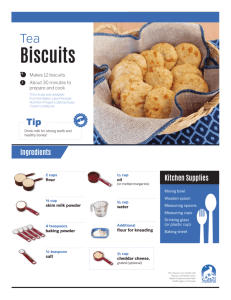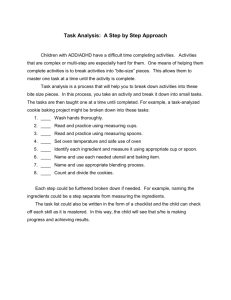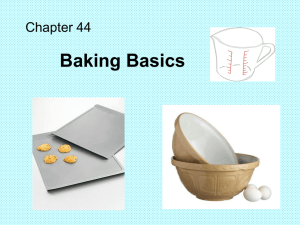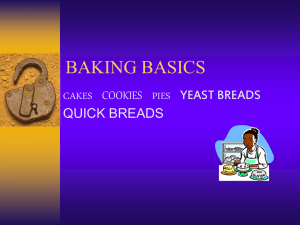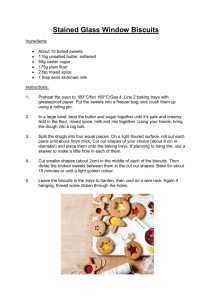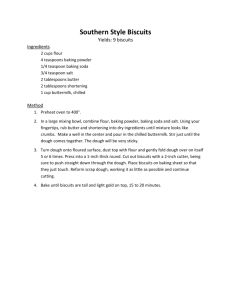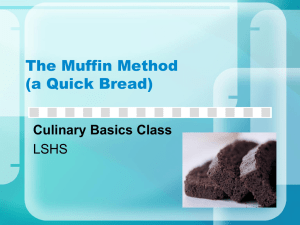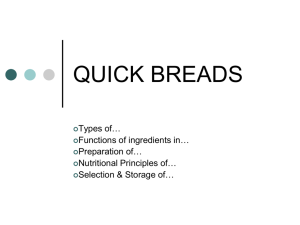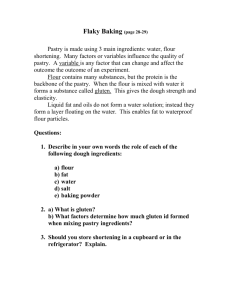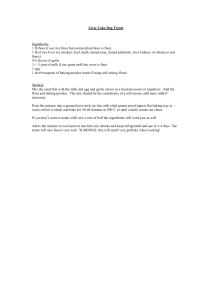Unit 9: The Art of Baking
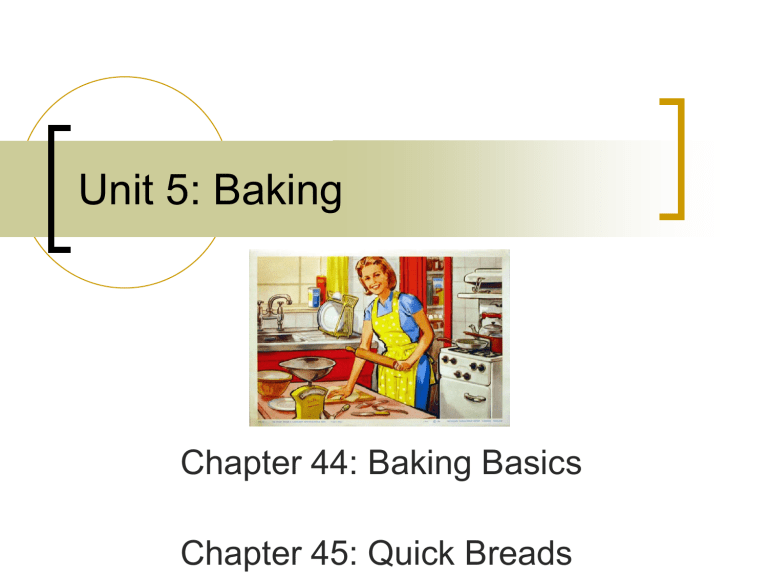
Unit 5: Baking
Chapter 44: Baking Basics
Chapter 45: Quick Breads
Red Lobster Biscuits…
Red Lobster bakes and serves more than 395 million of its famous
Cheddar Bay Biscuits every year.
395 million cheese biscuits would stretch a whopping 15,585 miles, or the distance of a trip from our New
York restaurant in Times Square all the way to Shanghai, China — and back!
Chapter 44:
Baking Basics
Ingredients for Baking
Directions: create a wagon wheel graphic organizer with
“Ingredients for Baking” in the center
Flour
Helps give structure to baked products
Gluten: develops as flour is mixed with liquid, the longer the mixing time - the stronger the gluten will be
Liquids
Make possible many physical and chemical changes that add structure and texture within baked products
Examples: Water, Milk, Juice, Buttermilk,
Sour cream, Yogurt
Baked goods are made from either batters or doughs
Batter vs. Dough (see next slide)
Higher ratio liquid to dry ingredients = batter
Higher ratio dry to liquid ingredients = dough
Pour batters : equal amounts of liquid and flour
Creates a thin and flowing pour
Cakes, pancakes, waffles
Drop batters : Twice as much flour as liquid
Dropped by spoonfuls onto pan
Quick breads, cookies
Soft doughs : One part liquid to 3 parts flour
Sticky but moldable
Yeast breads, rolled biscuits
Stiff doughs : One part liquid to 6-8 parts flour
Easiest to handle
Pie crusts, some rolled cookies
Leavening Agents
A substance that triggers a chemical reaction that makes baked products grow larger, or rise.
Examples : Air, Steam, Baking soda,
Baking powder, Yeast
Fats
Add richness and flavor to baked goods
Exact effect depends on the make up of the fat
Solid Fats : butter, margarine, shortening, lard
Add volume by trapping air
Oils : corn, canola, olive, vegetable
Add moistness and density, rather than volume
Sweeteners
Add flavor, tenderness, and browning
Examples: Sugars (granulated, confectioner’s, brown), Honey,
Molasses, Corn syrup
Eggs
The “MULTITASKER”
Yolks
Fat adds flavor, color, richness, and tenderness
Fats create emulsion (binding liquids and fats together in a recipe so they don’t separate)
Albumen
Beating the egg white proteins adds air and volume
Coagulation
Heating eggs helps to set the structure
Flavorings
Add variety to baked products
Examples : spices, liquid extracts, dried fruit, chopped nuts, chocolate, etc.
The Baking Process
1.
2.
3.
4.
5.
Choose oven temperature preheat
Choose and prepare the pans grease and flour, cooking spray, line with paper
Consider proper oven placement when baking see figure 44-7, page 617
Remove from pan see steps 1 - 7 on page 618
Store cool before storing, sealed container at room temp.
Chapter 45:
Quick Breads
Quick Breads
Leavened by agents that allow immediate baking
Examples : air, steam, baking soda, baking powder
Most quick bread are made by one of two different mixing methods
Muffin Method or Biscuit Method
Directions: Compare/contrast the following mixing methods
Biscuit Method vs. Muffin Method
Muffin Method of Mixing
Lightly mixing liquid ingredients into dry ingredients, creating a product with a course yet tender texture.
AVOID OVERMIXING
overmixing leads to a baked product that is chewy or has tunnels inside and peaks on top
Biscuit Method of Mixing
Solid fat is added to the dry ingredients before the liquids are lightly mixed in.
Biscuits are either rolled or dropped
Kneading : work dough with hands to combine ingredients and develop gluten

